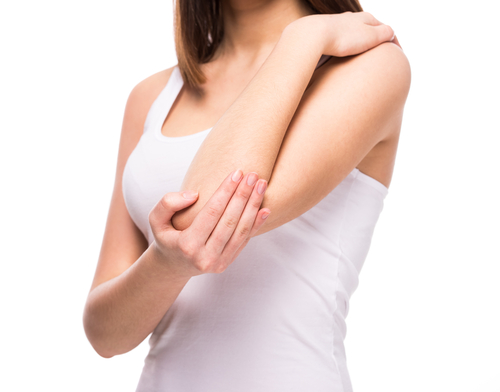Arm pain is defined as discomfort or pain experienced anywhere throughout the arm, and it can include pain in the wrist, elbow, and rotator cuff (junction of upper arm and shoulder).
Common causes
Simple sprain
If you think your pain has been caused by doing more activity than you’re used to, you may have just sprained your arm. This means the arm tissues have been stretched, twisted or torn, but aren’t permanently damaged. Avoid exercising the arm and care for it at home through the following remedies:
- Hold an ice pack to your arm for 15-20 minutes every few hours for the first couple of days
- Take over-the-counter painkillers, such as paracetamol or ibuprofen, to relieve the pain and any inflammation
- Rest the arm and keep it raised for as long as possible (try resting it on cushions) to help reduce any swelling and pain
See your doctor if your arm pain doesn’t improve after several days, or if there’s increasing redness, swelling or pain.
Tennis elbow or golfer’s elbow
Tennis elbow and golfer’s elbow are conditions that cause pain around the outside or inside of the elbow. They often occur after strenuous overuse of the muscles and tendons near the elbow joint (for example, after playing tennis or golf).
The pain caused by tennis elbow or golfer’s elbow can last for several weeks or months, but will eventually get better.
Bursitis
Repetitive movement of the arm can cause a build-up of fluid over the elbow joint, known as olecranon bursitis (the olecranon is the bony tip of the elbow). This results in pain and swelling.
Most cases of bursitis can be successfully treated with painkillers at home, but some cases will be complicated by infections and may need antibiotics (this is more common after sustaining a scratch or penetrating injury to the arm).
The pain will usually improve within a few weeks, although the swelling may take longer to completely disappear.
Squashed or trapped nerve
Sometimes, the general “wear and tear” that occurs in the joints and bones of the spine as a person gets older can cause the nerves in the spinal cord to become squashed or trapped. This can cause pain that radiates from the neck to the arms, and sometimes also pins and needles.
This type of wear and tear is known as spinal arthritis or cervical spondylosis.
Arm pain caused by cervical spondylosis varies from person to person, but it’s typical to have good days and bad days. In most cases, symptoms can be controlled using over-the-counter medication, such as ibuprofen or paracetamol, and exercise.
A trapped nerve can also occur in the arm itself. This can sometimes occur in the wrist (carpal tunnel syndrome) or in the elbow (cubital tunnel syndrome). Pain and tingling in your arm and hand that isn’t associated with neck pain may be caused by these conditions.
Angina
Angina is a heart condition caused when the blood supply to the muscles of the heart is restricted. It usually occurs when the arteries supplying the heart become hardened and narrowed.
Angina usually causes a dull, heavy or tight pain in the chest that can sometimes spread to the left arm, neck, jaw or back. The pain is usually triggered by physical activity or stress and often only lasts for a few minutes.
However, sometimes angina may only be felt as pain in the arm. This is why it’s important to see your GP as soon as possible if your arm pain comes on after exercise and is relieved with rest. Angina is a serious warning sign that you have an increased risk of more serious conditions, such as a heart attack or stroke.
Repetitive strain injury
Repetitive strain injury may be diagnosed if your arm or elbow pain seems to be caused by a repetitive task and then fades when the task is stopped. It often occurs in people who work with computers or carry out repetitive manual work.
Sometimes, the pain is caused by an underlying problem, such as bursitis or tendonitis.
Less common causes
Less commonly, arm pain may be caused by one of the following conditions or injuries:
- De Quervain’s tenosynovitis – inflammation of the tendons on the inside of the wrist
- Cervical rib – a condition where you have an extra rib above your normal top rib, which may cause pain, tingling or numbness in the arm
- Inflammation of the nerves in the arm (known as ‘brachial and ulnar neuritis’) – this may occur after shingles
- Damage to the nerves connecting the spine and the arm (a ‘brachial plexus injury’) – this can be caused by over-stretching the arm or shoulder and most often occurs during contact sports or a motor vehicle accident
- Arthritis of the elbow – which can cause the elbow joint to become inflamed (swollen, warm and painful) and feel stiff
- A broken arm – usually caused by a fall onto an outstretched arm
When to get immediate medical help
- If your arm pain is brought on by exercise and relieved with rest; it may be a sign of angina (restricted blood supply to the heart)
- If you think you may have a broken arm (but aren’t sure)
- If your arm becomes red, hot and swollen over a period of a few hours, and you start to feel generally unwell and develop a high temperature; you may have an infection
- If the pain has come on suddenly and your chest feels like it’s being squeezed (you may be having a heart attack or stroke)
- If you have obviously broken your arm (it looks the wrong shape)


